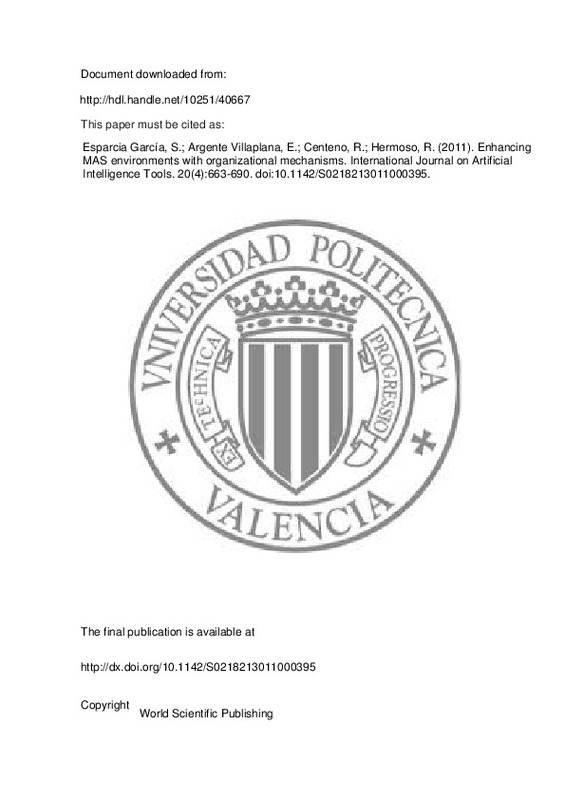JavaScript is disabled for your browser. Some features of this site may not work without it.
Buscar en RiuNet
Listar
Mi cuenta
Estadísticas
Ayuda RiuNet
Admin. UPV
Enhancing MAS environments with organizational mechanisms
Mostrar el registro sencillo del ítem
Ficheros en el ítem
| dc.contributor.author | Esparcia García, Sergio
|
es_ES |
| dc.contributor.author | Argente Villaplana, Estefanía
|
es_ES |
| dc.contributor.author | Centeno, Roberto
|
es_ES |
| dc.contributor.author | Hermoso, Ramón
|
es_ES |
| dc.date.accessioned | 2014-10-06T12:57:22Z | |
| dc.date.available | 2014-10-06T12:57:22Z | |
| dc.date.issued | 2011 | |
| dc.identifier.issn | 0218-2130 | |
| dc.identifier.uri | http://hdl.handle.net/10251/40667 | |
| dc.description | Electronic version of an article published as International Journal on Arti cial Intelligence Tools Vol. 20, No. 4 (2011) 663-691. DOI10.1142/S0218213011000395 © [copyright World Scientific Publishing Company] [http://www.worldscientific.com/] | es_ES |
| dc.description.abstract | This work proposes a new coordination system for the environment of a Multi-Agent System by merging the features from two important contributions to this field of research, Organizational Mechanisms and Artifacts. Organizational mechanisms can be introduced into a Multi-Agent System with the aim of influencing the behavior of agents populating it to achieve their goals in a proper way. In this paper, we propose to model organizational mechanisms by means of artifacts, which are non-proactive entities used by agents. Artifacts were presented within the Agents & Artifacts conceptual framework, and that present good advantages for coordinating agents' environments. We put forward a formal model that defines how organizational mechanisms can be designed by using artifacts theory. We validate the approach by presenting a case study focused on a real health care domain problem. Additionally, the Artifacts for Organizational Mechanisms are compared with some different proposed artifacts. © 2011 World Scientific Publishing Company. | es_ES |
| dc.description.sponsorship | This work is supported by TIN2009-13839-C03 and PROMETEO/2008/051 projects of the Spanish government, CONSOLIDER-INGENIO 2010 under grant CSD2007-00022, and the COST Action IC0801. | en_EN |
| dc.language | Inglés | es_ES |
| dc.publisher | World Scientific Publishing | es_ES |
| dc.relation.ispartof | International Journal on Artificial Intelligence Tools | es_ES |
| dc.rights | Reserva de todos los derechos | es_ES |
| dc.subject | Agent-oriented software engineering | es_ES |
| dc.subject | Artifacts | es_ES |
| dc.subject | Environment | es_ES |
| dc.subject | Organizational mechanisms | es_ES |
| dc.subject | Conceptual frameworks | es_ES |
| dc.subject | Coordination systems | es_ES |
| dc.subject | Domain problems | es_ES |
| dc.subject.classification | LENGUAJES Y SISTEMAS INFORMATICOS | es_ES |
| dc.title | Enhancing MAS environments with organizational mechanisms | es_ES |
| dc.type | Artículo | es_ES |
| dc.identifier.doi | 10.1142/S0218213011000395 | |
| dc.relation.projectID | info:eu-repo/grantAgreement/Generalitat Valenciana//PROMETEO08%2F2008%2F051/ES/Advances on Agreement Technologies for Computational Entities (atforce)/ | es_ES |
| dc.relation.projectID | info:eu-repo/grantAgreement/COST//IC0801/EU/Agreement Technologies/ | es_ES |
| dc.relation.projectID | info:eu-repo/grantAgreement/MEC//CSD2007-00022/ES/Agreement Technologies/ | es_ES |
| dc.relation.projectID | info:eu-repo/grantAgreement/MICINN//TIN2009-13839-C03-01/ES/Organizaciones Virtuales Adaptativas: Arquitecturas Y Metodos De Desarrollo/ | es_ES |
| dc.rights.accessRights | Abierto | es_ES |
| dc.contributor.affiliation | Universitat Politècnica de València. Departamento de Sistemas Informáticos y Computación - Departament de Sistemes Informàtics i Computació | es_ES |
| dc.description.bibliographicCitation | Esparcia García, S.; Argente Villaplana, E.; Centeno, R.; Hermoso, R. (2011). Enhancing MAS environments with organizational mechanisms. International Journal on Artificial Intelligence Tools. 20(4):663-690. https://doi.org/10.1142/S0218213011000395 | es_ES |
| dc.description.accrualMethod | S | es_ES |
| dc.relation.publisherversion | http://dx.doi.org/10.1142/S0218213011000395 | es_ES |
| dc.description.upvformatpinicio | 663 | es_ES |
| dc.description.upvformatpfin | 690 | es_ES |
| dc.type.version | info:eu-repo/semantics/publishedVersion | es_ES |
| dc.description.volume | 20 | es_ES |
| dc.description.issue | 4 | es_ES |
| dc.relation.senia | 192017 | |
| dc.contributor.funder | Ministerio de Educación y Ciencia | es_ES |
| dc.contributor.funder | European Cooperation in Science and Technology | es_ES |
| dc.contributor.funder | Ministerio de Ciencia e Innovación | es_ES |
| dc.contributor.funder | Generalitat Valenciana | es_ES |
| dc.description.references | E. Argente, Frontiers in Artificial Intelligence and Applications 113 (IOS Press, 2004) pp. 309–316. | es_ES |
| dc.description.references | A. Omicini, Agent-Oriented Software Engineering (Springer, 2001) pp. 311–326. | es_ES |
| dc.description.references | Parunak, H. V. D., & Weyns, D. (2006). Guest editors’ introduction, special issue on environments for multi-agent systems. Autonomous Agents and Multi-Agent Systems, 14(1), 1-4. doi:10.1007/s10458-006-9003-4 | es_ES |
| dc.description.references | BERNON, C., COSSENTINO, M., & PAVÓN, J. (2005). Agent-oriented software engineering. The Knowledge Engineering Review, 20(2), 99-116. doi:10.1017/s0269888905000421 | es_ES |
| dc.description.references | Hübner, J. F., Boissier, O., Kitio, R., & Ricci, A. (2009). Instrumenting multi-agent organisations with organisational artifacts and agents. Autonomous Agents and Multi-Agent Systems, 20(3), 369-400. doi:10.1007/s10458-009-9084-y | es_ES |
| dc.description.references | Van Gigch, J. P. (1991). System Design Modeling and Metamodeling. doi:10.1007/978-1-4899-0676-2 | es_ES |
| dc.description.references | Norman, T. J., Preece, A., Chalmers, S., Jennings, N. R., Luck, M., Dang, V. D., … Fiddian, N. J. (2004). Agent-based formation of virtual organisations. Knowledge-Based Systems, 17(2-4), 103-111. doi:10.1016/j.knosys.2004.03.005 | es_ES |







![[Cerrado]](/themes/UPV/images/candado.png)

